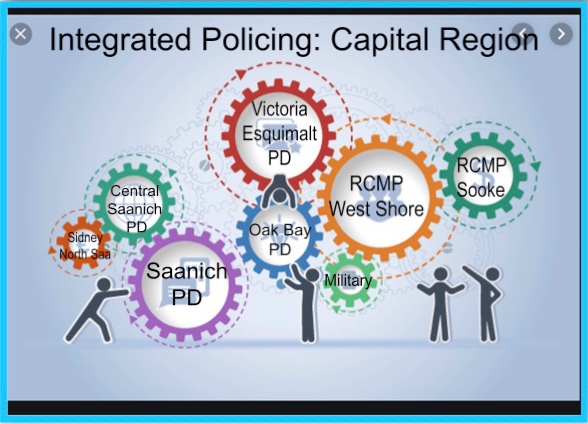Changing the way police do business (Part IV)

Your police forces work cooperatively to provide the best service possible. Locally, across the nation, and around the world integration is the best model to follow in terms of bringing together the disparate parts of policing in common purpose.
Part I. Police solidarity and the push for amalgamation
Part II, Comparing differing police cultures
Part III, The past as a guide to the future
Link to CBC Podcast: Policing in the CRD
Part IV: Integration vs Amalgamation
1. Introduction
By the time you’ve reached this part, and assuming you read the first three parts, you may understand why amalgamating police forces is likely the biggest mistake that could be made in terms of addressing modern-day policing challenges in the Capital Region. While amalgamation seems intuitively reasonable, those who promote the idea do not take into account the powerful forces at play even in organizations as similar as the police agencies within the Captial Region.
Take the banking system as an example. Would anyone think it reasonable to merge banks into one as serving the best interests of the people in Greater Victoria? In terms of function, the police are no different than a bank, in that they perform an essential public service within an ever-expanding circle from local to national and international.
To function at their best, each constituent part must work at integrating their system into the whole, one that maximizes not only their ability to solve internal challenges but, at the same time, expanding their ability to work together in common purpose. That is were integration outpaces amalgamation.
Even a partial merger, say that of Victoria and Saanich, would be immensely difficult and extremely damaging to both forces. While VicPD may gain an increase in staffing levels, as they did in with Esquimalt merger, the underlying issues facing VicPD could very well be exacerbated. You might simply have a larger force with the same problems. In side-discussions with persons whose opinions I trust, I rather think that has happened in areas where moderate and large scale amalgamations have taken place.
The beautiful thing about integration is that it allows each police agency to maintain an individual identity, while at the same time fully participating and cooperating as a part of the whole.
Across the Capital Region, throughout B.C., and across Canada, integration has become the modern, forward-looking way of bringing disparate police forces, as well as other emergency service providers and community groups, together in common purpose. By doing this, no one group dominates the whole.
The contrary happens with amalgamation. First, you amalgamate, then you must try to divide the whole into equitable parts. That is what the former Victoria Chief Constable (Jamie Graham) proposed with his “Four District” plan as outlined in Part II of this series (Section 6). The likely outcome? Only one culture would survive and that particular culture may not be the best. Perhaps, many discerned that in the VicPD/Esquimalt merger as expressed in this article in the Victoria News on March 13, 2019: Local powers say a regionalized police force needed for Greater Victoria: VicPD, Victoria, Esquimalt, and Grumpy Taxpayer$ argue for police amalgamation
This part of the series will explore the nature of integration in the Captial Region and how that integration is changing the face of policing as it was often practiced through much of the last century. It is a form of police merger the selects best practices and expands them to the entire region on a voluntary basis. For those who choose to withdraw and go it alone, it’s at their peril.
2. The Methods of Integration
The balance of this article is still being written and will be completed within a week to ten days. Part of the reason for the delay is awaiting input from both internal and external police sources.
As a beginning, please take a few moments to consider the following aspects of integration that have already taken place within the Capital Region. These headings are copied from Oak Bay Police documents, a police agency that has fully involved its members in the integration project. Go to the site link for a more complete explanation of each of the following items.
Police Integration in the Captial Region

Integrated Units
- RDVU–Regional Domestic Violence Unit
- MYST – Mobile Youth Services Team
- IMCRT–Integrated MobileCrisis Response Team
- GVPDAC – Greater Victoria Police Diversity Advisory Committee
- VIIMCU–Vancouver Island Integrated Major Crimes Unit
- CFSEU–Combined Forces Special Enforcement Unit
- IRSU–Integrated Road Safety Unit
- Greater Victoria Crime Stoppers
- E-INSET–Integrated National Security Enforcement Team
- E-Comm–Consolidated Dispatch
- GVERT–Greater Victoria Emergency Response Team
- CMU–Crowd Management Unit
- ITCU–Integrated Tech Crimes Unit
- SPD/OBPD shared services agreement
- OBPD Detective working out of Saanich Detective Office (2-year trial)
- Sharing of recruit scoring/polygraph
- POPAT Testing
- Mutual aid when needed
- Routine cooperation among agencies
The Organizational Structure
- Regional Joint Management Team (Deputy Chiefs) reporting to Area Police Chiefs
- Overall strategic oversight of the integrated units
- Each unit has an individual JMT (Joint Management Team) and/or unit supervisor
- Day-to-day operations are overseen by unit supervisors and/or JMT
Operations/Oversight
- Annual budgets/reports are prepared and forwarded to RJMT (Regional JMT)
- RJMT assesses budgets, activities and looks for any needed changes
- Area Chiefs approve provisional budgets and changes
- Final approval by Police Board(s) prior to presentation to Councils
Participation Criteria
- Ongoing discussions around possibilities in a variety of areas
- Each agency must assess the value of participation using a wide range of metrics – depending on service need
- Consideration of:
- Crime Trends
- Identified gaps in service
- Resource efficiency
- Organizational risk
Participation Considerations
- Overall value for investment is the main consideration – Is participation meeting need
- Can accomplish more collectively than individually
- Consideration of Provincial Policing Standards
Participation: Opt-in / Opt-out
- All parties engage in discussions
- Only participating agencies have the right to vote
- Minimum commitment of 3 years to units
- Notice of one full budget year required to opt-out
- Decision with Police Chiefs with input from Police Boards
- Board approval for new resources
Funding Sources
- Standardized funding formulas have been established:
- Units involving the RCMP:
- 1/4 each of strength, population, assessment, and file count
- Units not involving the RCMP:
- 1/3 each of strength, population, and assessment
Continuation in Progress (this post will be continued when other examples of integration)
The balance of this article will focus on additional ways and means of integrating services as follows from the experience of other agencies across BC and Canada.
Given the VicPD joint force apparently faces several pressing problems, special attention will be given to those challenges, and how others might help to relieve the pressure. Coincidently, many of the challenges are not all that different from those experienced in many other urban and suburban areas across Canada.
(276)
Trackback from your site.

Comments (1)